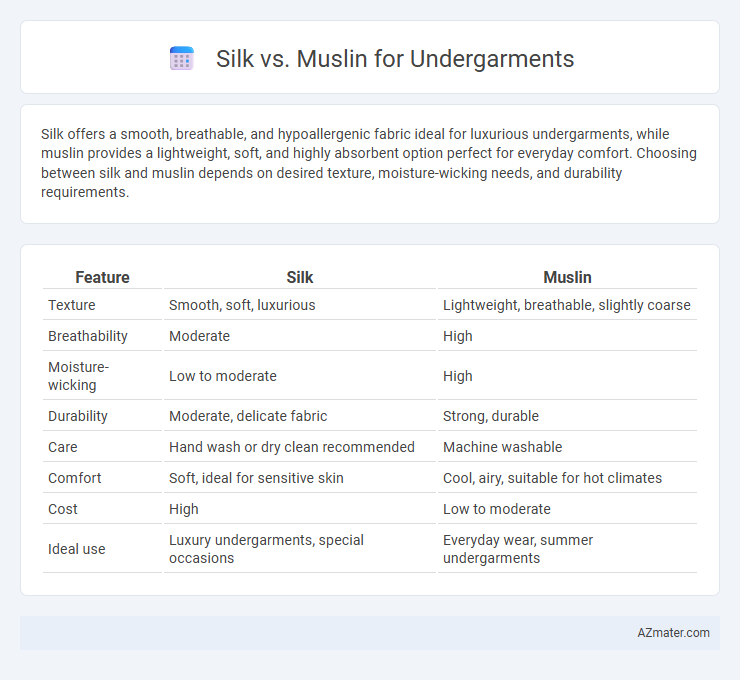Silk offers a smooth, breathable, and hypoallergenic fabric ideal for luxurious undergarments, while muslin provides a lightweight, soft, and highly absorbent option perfect for everyday comfort. Choosing between silk and muslin depends on desired texture, moisture-wicking needs, and durability requirements.
Table of Comparison
| Feature | Silk | Muslin |
|---|---|---|
| Texture | Smooth, soft, luxurious | Lightweight, breathable, slightly coarse |
| Breathability | Moderate | High |
| Moisture-wicking | Low to moderate | High |
| Durability | Moderate, delicate fabric | Strong, durable |
| Care | Hand wash or dry clean recommended | Machine washable |
| Comfort | Soft, ideal for sensitive skin | Cool, airy, suitable for hot climates |
| Cost | High | Low to moderate |
| Ideal use | Luxury undergarments, special occasions | Everyday wear, summer undergarments |
Introduction to Silk and Muslin Fabrics
Silk, a natural protein fiber produced by silkworms, is renowned for its smooth texture, durability, and moisture-wicking properties, making it an ideal choice for luxurious undergarments. Muslin, a lightweight cotton fabric known for breathability and softness, offers excellent comfort and airflow, especially in warm climates. Both fabrics provide unique benefits: silk excels in temperature regulation and elegance, while muslin emphasizes natural breathability and affordability.
Historical Use of Silk and Muslin Undergarments
Silk undergarments have a long history of luxury and comfort, prized for their smooth texture and hypoallergenic properties since ancient China and India, where silk production originated. Muslin, a finely woven cotton fabric, was widely used in South Asia and Europe from the 17th century onward due to its breathability and affordability, making it a popular choice for undergarments and summer wear. Both fabrics played significant roles in historical fashion, with silk often symbolizing status in royal and aristocratic circles, while muslin became a staple for everyday comfort and practicality.
Texture and Comfort Comparison
Silk offers a smooth, luxurious texture that feels cool and soft against the skin, making it ideal for sensitive or delicate areas. Muslin, made from loosely woven cotton, provides a breathable, lightweight feel that enhances comfort by allowing better air circulation. While silk excels in softness and sheen, muslin stands out for its durability and moisture-wicking properties, catering to different comfort preferences in undergarments.
Breathability and Moisture-Wicking Abilities
Silk offers moderate breathability with natural temperature-regulating properties that keep the skin dry and comfortable, making it suitable for undergarments. Muslin excels in breathability due to its loosely woven cotton fibers, allowing superior airflow and enhanced moisture-wicking capabilities that prevent sweat buildup. For hot and humid conditions, muslin undergarments provide better ventilation and moisture management compared to the smoother, less porous silk fabric.
Durability and Longevity of Silk vs Muslin
Silk undergarments offer superior durability compared to muslin due to their natural protein fiber structure, which resists wear and tear while maintaining softness over time. Muslin, made from loosely woven cotton, tends to fray and lose integrity faster, especially with frequent washing and use. Investing in silk ensures longer-lasting undergarments that retain their shape and luxurious feel, making them a preferred choice for durability and longevity.
Skin Sensitivity and Allergen Considerations
Silk undergarments are renowned for their hypoallergenic properties, making them ideal for sensitive skin prone to irritation or allergic reactions. Muslin, a loosely woven cotton fabric, offers breathability but may lack the smooth texture and gentle touch silk provides, potentially causing discomfort for those with delicate skin. Choosing silk over muslin enhances comfort by minimizing skin sensitivity and reducing the risk of allergens due to its natural protein structure and moisture-wicking abilities.
Maintenance and Care Requirements
Silk undergarments demand delicate care, requiring hand washing or gentle machine cycles with mild detergents and air drying to maintain fabric integrity and sheen. Muslin undergarments offer easier maintenance as they can typically withstand machine washing at moderate temperatures, but should be dried flat to prevent shrinkage and preserve softness. Proper care for both fabrics extends garment lifespan, with silk needing more meticulous handling due to its natural protein fiber structure compared to the loosely woven cotton fibers of muslin.
Cost and Accessibility of Silk and Muslin
Silk undergarments generally come at a higher cost due to the labor-intensive production process and the premium quality of natural silk fibers, making them less accessible to budget-conscious consumers. Muslin, made from loosely woven cotton, offers a more affordable and widely available alternative, often found in various markets and stores at lower price points. The cost-effectiveness of muslin makes it a popular choice for everyday undergarments, while silk remains a luxury option favored for its softness and durability.
Best Use Cases for Each Fabric
Silk offers exceptional softness and natural temperature regulation, making it ideal for luxury lingerie and sensitive skin undergarments that require breathability and moisture-wicking properties. Muslin's lightweight, breathable, and slightly textured fabric is perfect for casual, everyday undergarments and sleepwear that prioritize comfort and durability. Choosing between silk and muslin depends on the need for luxury and moisture control versus practicality and ease of care in undergarments.
Conclusion: Choosing the Right Fabric for Your Undergarment
Silk offers luxurious softness, natural temperature regulation, and moisture-wicking properties, making it ideal for those seeking comfort and elegance in undergarments. Muslin provides breathability, lightweight texture, and affordability, perfect for sensitive skin and casual wear. Selecting between silk and muslin depends on prioritizing luxury and durability versus breathability and budget-friendly options.

Infographic: Silk vs Muslin for Undergarment
 azmater.com
azmater.com